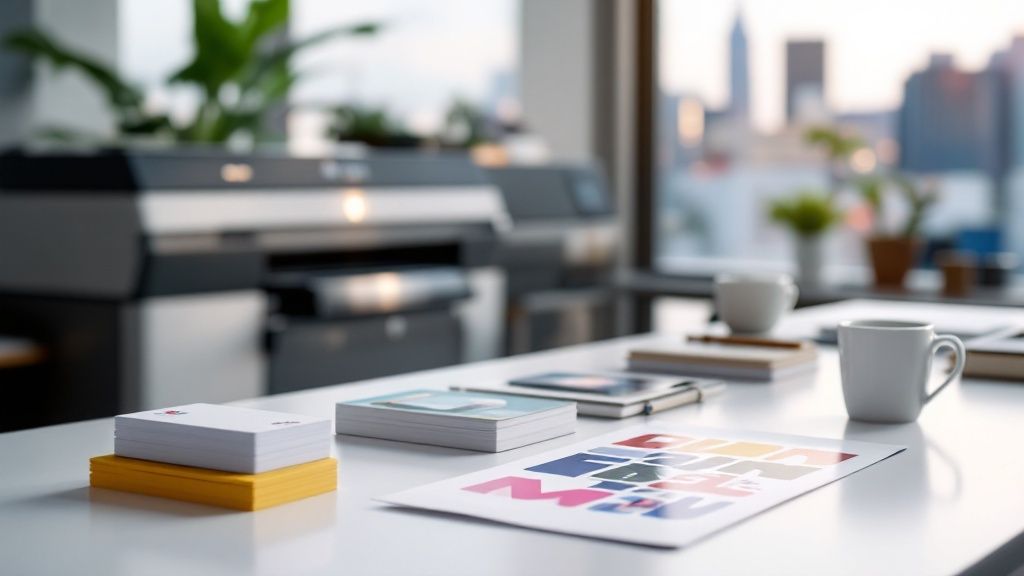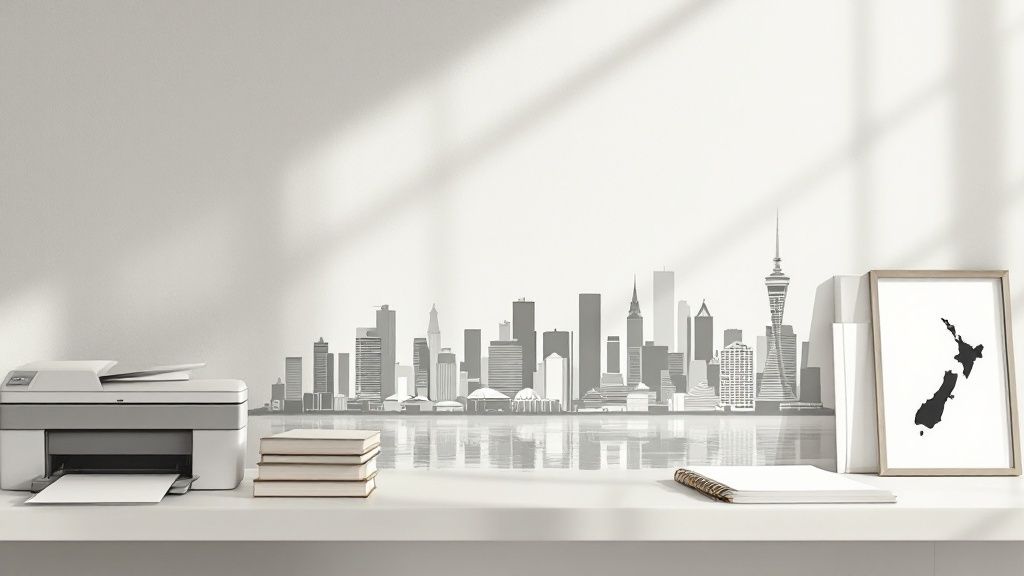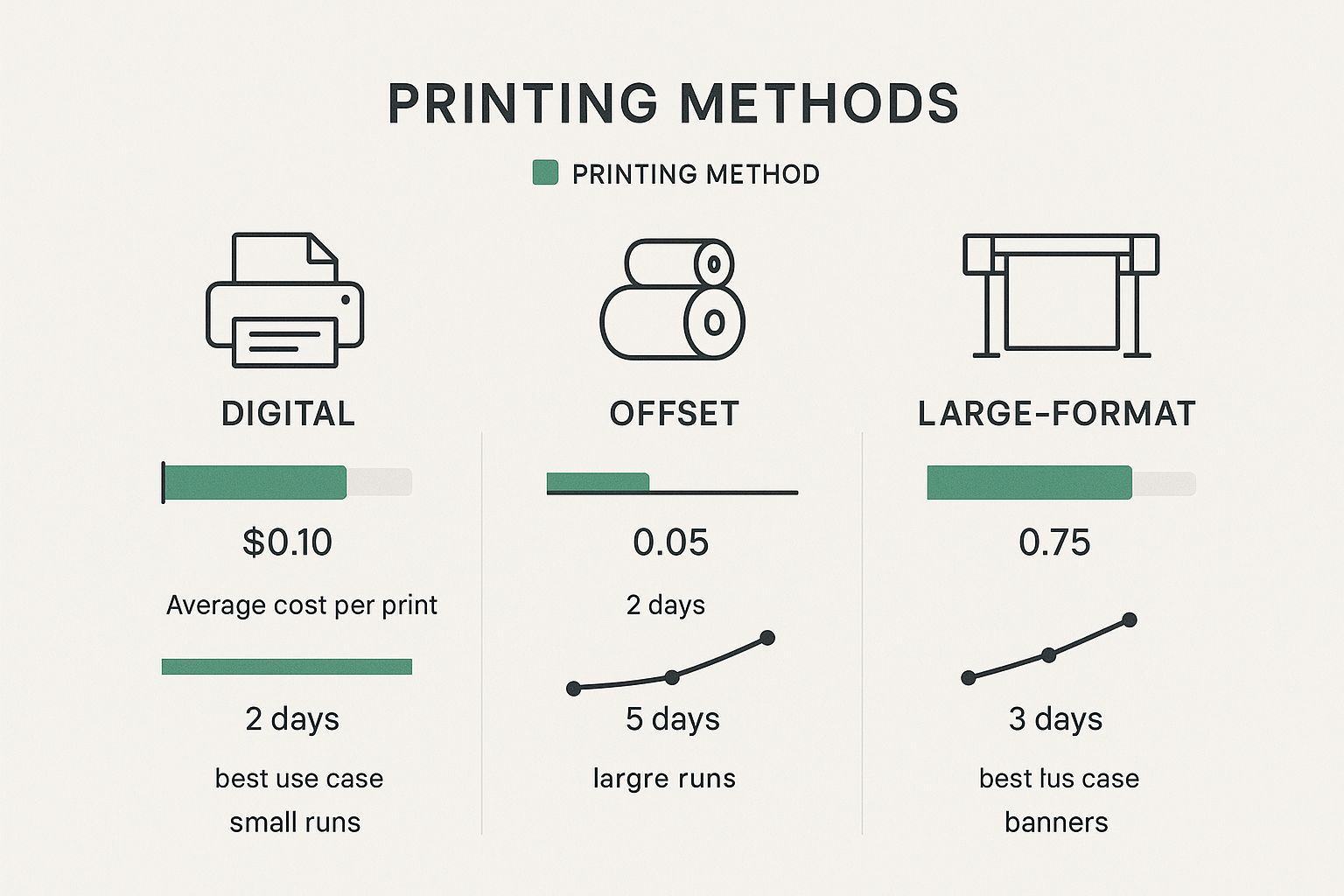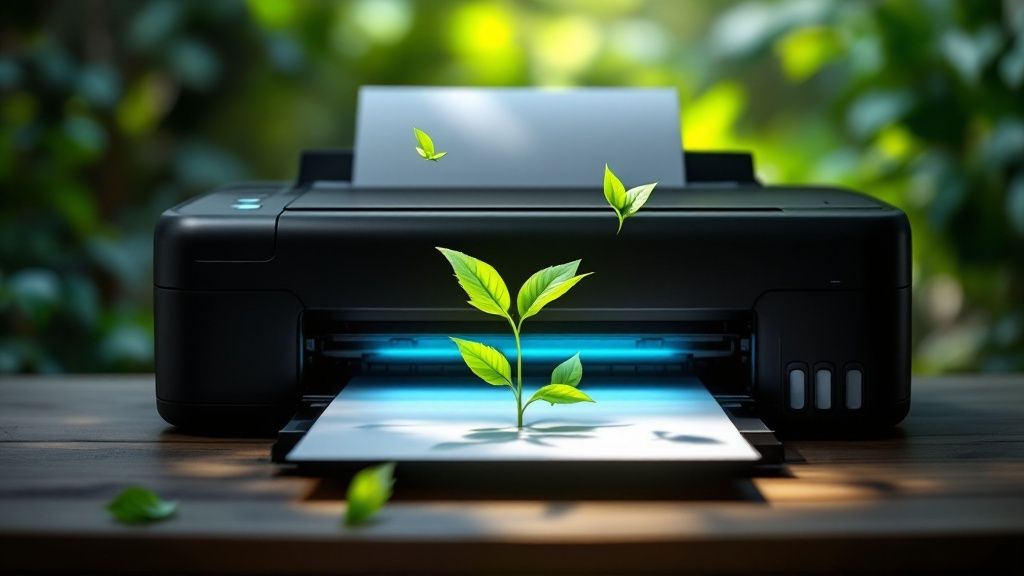Your cart is currently empty.

When you're trying to turn a digital idea into something real and tangible, finding the right print services in Auckland is a game-changer. It’s about more than just ink on paper; it's about creating business cards that leave a lasting impression or banners that stop people in their tracks. Your choice of print partner can make all the difference.
Your Guide to Auckland's Printing Landscape

Think of this as your complete guide to navigating Auckland's vibrant print scene. In a world saturated with digital content, high-quality printed materials offer a tactile connection that screens just can't match. This guide is your roadmap to making a real-world impact, no matter the size of your business.
We’ll break down the entire process, helping you get your head around the different technologies and figure out which one is the right fit for your project. Whether you're a startup needing your first run of brochures or an established company planning a major campaign, making an informed choice is key to a professional result.
Why a Local Print Partner Matters
Opting for a local Auckland printer gives you more than just convenience. A local team gets the nuances of the market here. They can offer personalised service, quicker turnarounds, and let you get hands-on with quality control. That direct collaboration is what turns a good idea into a brilliant final product.
The New Zealand printing industry is a competitive space. Recent figures show around 774 printing businesses are operating across the country, with a huge number of them right here in Auckland. While the industry has seen some changes, it's expected to stabilise, which means businesses will continue to have plenty of expert local options. You can read more about the national printing business landscape from IBISWorld.
When you team up with a local expert, you're not just getting a supplier. You're getting a collaborator who’s invested in your success, making sure every flyer, brochure, and sign truly reflects your brand.
This guide will walk you through everything you need to know. We'll cover the key differences between digital and offset printing and help you choose a provider that aligns with your quality standards and budget, ultimately boosting your physical presence in the market.
Digital vs Offset Printing: What Your Business Needs
When you're looking for print services in Auckland, one of the first big questions you'll face is whether to go with digital or offset printing. Getting this right is crucial for your budget and the final quality of your project. Think of it this way: digital printing is like a high-speed jet boat perfect for quick, agile trips, while offset printing is more like a massive container ship, built for heavy, long-haul journeys. Both get you across the water, but they're designed for completely different tasks.
So what's the difference? Digital printing is pretty much what it sounds like. A digital file (like a PDF) is sent directly to the printer, which then applies the ink or toner straight onto the paper. It's a lot like your high-end office printer, just on a much more powerful and professional scale. There are no custom plates involved, making the whole process direct and fast.
Offset printing, on the other hand, is the traditional powerhouse of the industry. It’s a more mechanical process where your design is first etched onto custom metal plates. These plates transfer ink to a rubber blanket, and that blanket then rolls the ink onto the paper. It's a more involved setup, but once the machinery is rolling, it's incredibly efficient.
When Digital Printing Shines
Digital printing is the undisputed champion of speed and small-run projects. Because you skip the whole plate-making process, the turnaround time can be incredibly quick. It's the perfect choice for those last-minute jobs, like running off a few hundred flyers for a weekend event at the Aotea Centre or printing updated menus for your restaurant.
This method is also your most budget-friendly option for smaller quantities. If you only need 50 brochures or 100 business cards, digital printing is almost always the cheaper way to go. It’s also the only game in town for what's called 'variable data printing'—think personalised wedding invitations with each guest's name, or direct mailers addressed to individual customers.
The real magic of digital printing is its agility. It gives Auckland businesses the power to get high-quality, targeted materials printed fast, without needing to commit to a massive print run.
The Power of Offset Printing
Offset printing is where you turn for the big jobs. While setting up the plates has an upfront cost, the price per item plummets as your print quantity goes up. If you're printing thousands of product catalogues for a nationwide launch or a massive batch of corporate newsletters, offset delivers incredible value for money.
This method is also legendary for its colour fidelity. Offset printing uses the Pantone Matching System (PMS), which allows printers to mix inks to create exact, specific colours. This is non-negotiable for brands that need their signature red or blue to be perfect every single time. It guarantees that the first print and the ten-thousandth print are absolutely identical, protecting your brand's integrity.

As you can see, the best choice really hinges on the scale of your project, how quickly you need it, and what you plan to do with it.
To make it even clearer, here's a quick side-by-side look at how the two methods stack up.
Digital vs Offset Printing: A Quick Comparison
| Feature | Digital Printing | Offset Printing |
|---|---|---|
| Best For | Short to medium runs (e.g., 1-1000 items) | Large volume runs (e.g., 1000+ items) |
| Turnaround | Very fast, sometimes same-day | Slower due to plate setup |
| Cost | Low setup cost, higher cost per item | High setup cost, very low cost per item |
| Colour | Good quality (CMYK), but less precise | Superior, exact colour matching (PMS) |
| Personalisation | Excellent for variable data (e.g., names, addresses) | Not possible; every print is identical |
| Paper Stock | Good flexibility, some limitations | Huge range of paper types and finishes |
Ultimately, this table helps you see at a glance where each method excels.
Making the Right Choice for Your Project
So, how do you decide? It really comes down to four simple questions about your specific job:
- Quantity: How many do you need? For runs under about 500-1000 pieces, digital is your friend. For anything more, it’s time to talk offset.
- Turnaround: How fast do you need it? If it's urgent, go digital. Many Auckland printers can turn jobs around in 24 hours.
- Colour: Is perfect brand colour matching essential? If you need a specific Pantone colour, offset is the only way to guarantee it.
- Personalisation: Does each piece need to be unique? If you're printing custom names or codes, digital printing is your only option.
By thinking through these factors, you can walk into any Auckland print shop and know exactly what to ask for. You'll get a final product that not only looks fantastic but also makes perfect sense for your timeline and budget.
Exploring Specialised Print Services in Auckland

While brochures and business cards are the bread and butter of any business, the print world stretches far beyond a standard A4 page. Specialised print services in Auckland are where you can get really creative, helping your brand to capture attention, create memorable experiences, and physically stand out from the crowd.
Think of it as the difference between a standard film and the full IMAX experience. Services like large format printing, promotional products, and custom packaging are all designed to make a much bigger, bolder impact. They're strategic tools that can seriously boost your brand's visibility and connect with customers in a very tangible way.
Large Format Printing for Maximum Visibility
Large format printing is exactly what it sounds like—it’s about going big. This is the world of towering banners, eye-catching billboards, vibrant pull-up displays for trade shows, and crisp vinyl decals for your storefront. It’s the art of getting your message seen from a distance, turning heads, and driving people to your door.
Imagine a festival happening at Western Springs Park. Its success hinges on durable, weather-resistant banners that guide people around and give sponsors their moment in the spotlight. That's large format printing in action. It's the same principle behind a real estate agent's high-impact "For Sale" sign that you can easily read from across the street.
These printers use specialised inks and hardy materials built to last, whether they're facing the Auckland sun or just the office air-con.
- Banners and Signage: Perfect for events, shopfronts, and promotions.
- Posters and Displays: Great for in-store marketing and making your trade show booth pop.
- Vehicle Wraps: Turns your company car or van into a mobile billboard.
- Window Graphics: Makes the most of your physical space for advertising.
Promotional Products That Build Brand Loyalty
This is where your brand gets to jump off the page and into your customers' hands. Promotional product printing is all about putting your logo or message onto useful, everyday items like pens, drink bottles, tote bags, and t-shirts. It's a fantastic, tangible way to build brand recognition and a bit of goodwill.
Think about a local Auckland gym that gives new members a branded water bottle. Every time that person takes a sip, they’re getting a subtle reminder of the gym. It's this kind of consistent, low-key exposure that builds a real connection and can turn a casual customer into a loyal advocate.
Promotional products aren't just freebies; they're functional marketing tools that create lasting impressions. In fact, research shows that 85% of people will do business with a company after receiving a promotional item from them.
Custom Packaging That Sells Your Product
On a crowded retail shelf, your product's packaging is often its first—and sometimes only—sales pitch. Custom packaging printing lets you design boxes, labels, and sleeves that do more than just protect what's inside; they tell your brand's story. It turns a simple container into a core part of the customer experience.
Picture an artisan chocolatier at La Cigale French Market. Their unique, beautifully printed boxes don't just hold chocolates; they communicate quality, care, and craftsmanship before anyone even takes a bite. That attention to detail can be the very thing that seals the deal. This is where specialised print services in Auckland can give you a real, tangible edge.
How to Choose the Right Auckland Printing Partner
Picking a print service in Auckland can feel a bit like wading through mud, but it doesn't have to be so complicated. The trick is to stop thinking about it as a simple transaction. You're not just buying paper and ink; you're bringing a crucial partner onto your team.
Get it right, and your printer becomes a genuine asset who can make your project shine. Get it wrong, and you're stuck with frustrating delays and expensive reprints. It’s a decision worth getting right.
So, where do you start? Forget the price list for a moment. A truly great printing partner is defined by their craftsmanship, their reliability, and how well they communicate. Before you sign anything, ask to see a portfolio. Get your hands on their past work and really look at the details that matter for your own projects—is the colour vibrant? Is the text crisp? How does the finishing feel?
Evaluate Quality and Reputation
A printer’s portfolio is their CV. Don't just glance at it; look for examples that are similar to what you have in mind. If you need high-end brochures, check out their work on similar paper stocks and with complex finishes. This gives you a real, tangible sense of what they can actually deliver.
Next, do a little digging into what past clients have to say. Online reviews on platforms like Google are a goldmine of information about a company's consistency and customer service. Are people raving about them hitting tight deadlines, or are there grumbles about missed delivery dates? Positive feedback is great, but pay attention to how they handle things when they go wrong.
For businesses looking into specific setups like print on demand, the vetting process is even more critical. It’s worth taking the time to understand how to choose the best print on demand suppliers to avoid headaches down the line.
The Importance of Communication and Proofing
Clear, proactive communication is absolutely non-negotiable. You want a partner who is responsive, easy to get hold of, and happy to offer their expert advice. They should be asking you questions to get the full picture, not just quietly taking your order and hoping for the best.
The proofing process is a huge part of this communication loop. Always, always ask how they handle proofs.
- Digital Proofs: This is usually a PDF sent over email. It’s perfect for a final check of the layout, spelling, and grammar.
- Hard Copy Proofs: For any project where colour is critical, a physical sample printed on your chosen paper is essential. It’s the only way to know for sure how your colours will look in the final run.
Never, ever skip the proofing stage. It’s your last line of defence against a typo or colour issue before hundreds or thousands of copies are run off. A good printer will insist on getting your sign-off—it protects both of you from a costly disaster.
The printing industry here in New Zealand has certainly seen some big changes, with revenue declining to an estimated $1.2 billion NZD by 2023 as more things go digital. The upside for customers? The established printers who remain are more focused than ever on delivering top-notch quality and service to keep their clients.
By carefully vetting potential partners on their work, reputation, and processes, you can find a team that will consistently deliver fantastic results.
Understanding Print Costs for the Best Value

Trying to figure out printing costs can feel like a guessing game, but it doesn't have to be. Getting your head around what goes into a print quote is the first step to making sure you get real value for your money.
Think of it like getting a custom suit made. The final price tag isn't just one thing; it’s a mix of the fabric you choose, the complexity of the cut, and any special features you add. Printing is much the same. Every decision, from the paper to the finish, shapes the final cost, so knowing the moving parts helps you spend wisely without sacrificing quality.
Core Factors That Influence Your Quote
So, what actually drives the price up or down? A few key things have a big impact on any print job. The most significant is almost always order quantity. The magic of offset printing means that the more you print, the cheaper each individual item becomes. Ordering 1,000 brochures will give you a much, much better price-per-unit than just ordering 100. It’s all about economies of scale.
Then there’s the material itself. Paper comes in a huge range of weights (measured in gsm – grams per square metre), textures, and special finishes. A hefty, premium cardstock for a business card that feels substantial in your hand is naturally going to cost more than standard, lightweight paper for a temporary flyer.
Here’s a quick rundown of the main cost drivers:
- Paper Stock: The paper’s thickness, finish (like glossy or matte), and overall quality.
- Colour Complexity: Simple black-and-white is your most budget-friendly option. Full-colour (known as CMYK) is the norm, but if you need an exact brand colour match using a special Pantone ink, that will add to the cost.
- Finishing Touches: This is where you can add that "wow" factor. Things like laminating, embossing (creating a raised effect), foil stamping, or custom shape cutting will lift the final product but also the price.
- Turnaround Time: Need it yesterday? Most printers can work miracles, but rush jobs often come with a priority fee. If you can be flexible with your deadline, you'll likely save some money.
Making Smart Choices for Maximum Value
Once you understand these variables, you’re in a great position to have a productive chat with your Auckland printer. You can start making strategic trade-offs. For example, if the budget is a bit tight, maybe you could choose a slightly lighter paper stock or stick to the standard CMYK colour process instead of a speciality ink. Small tweaks can often lead to decent savings.
To get a feel for how different elements interact on price, you could even play around with a specialized book printing cost calculator. While it’s for books, the principles of how paper, quantity, and finishes affect the total are universal.
Getting an accurate quote starts with a clear brief. The more detail you can give your printer about what you need—quantity, materials, finish, and deadline—the more precise their pricing will be. No surprises.
This is all happening in a city that’s the heart of New Zealand's printing industry. Auckland is the country's main employment hub for print, and local businesses are constantly getting more efficient, especially with digital services. By having an open conversation with your chosen printer, you can work together to figure out where to invest your budget for the biggest impact on your final product.
Your Top Auckland Print Questions, Answered
Jumping into the world of printing can feel a bit like learning a new language. You've got a vision, but how do you make sure it translates perfectly onto paper? To help clear things up, we've pulled together answers to the most common questions we hear from businesses across Auckland.
Think of this as a no-nonsense guide to getting your print job done right. A little bit of know-how goes a long way in planning your project, talking to your printer, and making sure the final result is exactly what you had in mind.
How Long Will My Print Job Take?
This is the big one, and the honest answer is: it depends. The timeline for a print job is shaped by the complexity of the work and the method used.
For straightforward digital printing—think business cards, flyers, or simple brochures—the turnaround is usually pretty quick. You could be looking at as little as 1-3 business days.
But if you’re planning something a bit more ambitious, you'll need to factor in more time. Big offset runs, custom-designed packaging, or anything with special finishes like foil stamping or die-cutting will naturally take longer, often in the realm of 5-10 business days. It's always best to chat with your printer about your deadline right from the start. Most Auckland printers can offer an express service if you're in a tight spot, though it will likely cost a bit extra.
What’s the Best File Format for Printing?
Getting the file format right is probably the single most important step for quality. The gold standard, without a doubt, is a high-resolution PDF. This format is fantastic because it bundles all your fonts, images, and layout elements into one neat package, ensuring what you see on your screen is precisely what the printing press will see.
To make sure your PDF is truly "print-ready," here are three non-negotiables:
- Resolution: For images to look sharp and clear, not fuzzy or pixelated, they must be at 300 DPI (dots per inch).
- Colour Mode: Your file needs to be set up in CMYK—Cyan, Magenta, Yellow, and Key (Black). This is the four-colour model that professional presses use. Files designed in RGB (Red, Green, Blue) are for screens and the colours will look off when they’re printed.
- Bleed: If any part of your design touches the edge of the page, you must add 3mm of bleed. This is a small buffer zone that gets trimmed off, preventing any ugly white slivers from showing up on the final product.
Can I See a Sample Before You Print the Whole Lot?
Yes, and you absolutely should! Any good printer in Auckland will have a solid proofing process. This is your last line of defence to catch a typo or a misplaced image before it’s too late.
You'll almost always get a digital proof (a PDF) to look over first. It's perfect for a final check of the layout, text, and overall design.
For projects where the colour needs to be spot-on—like matching a specific brand colour—it's worth asking for a physical or 'hard copy' proof. This is a printed sample on the actual paper stock you’ve chosen. It might cost a little more, but it gives you total confidence that the colours will turn out just right.
Are There Eco-Friendly Printing Options in Auckland?
Definitely. Being environmentally conscious is a huge priority for many Kiwi businesses, and printers have stepped up with some great green alternatives.
A great place to start is with the paper. Ask your printer about FSC (Forest Stewardship Council) certified stocks. This seal of approval means the paper comes from responsibly managed forests. Using recycled paper is, of course, another excellent choice for lowering your environmental impact.
It’s not just about the paper, though. The inks matter too. Look for printers who use vegetable or soy-based inks. Unlike their traditional petroleum-based cousins, these are far more sustainable and make the paper much easier to recycle down the line.
Ready to bring your ideas to life with a team that cares about the details as much as you do? At SONI DESIGN, we blend passion and precision to deliver exceptional signage, digital prints, and promotional products. Let's work together to tell your brand's story. Visit us today to start your next project!
Leave a Comment
Stay home & get your daily
needs from our shop
Start You'r Daily Shopping with Nest Mart
Best prices & offers
Orders $50 or more
Free delivery
24/7 amazing services
Great daily deal
When you sign up
Wide assortment
Mega Discounts
Easy returns
Within 30 days
